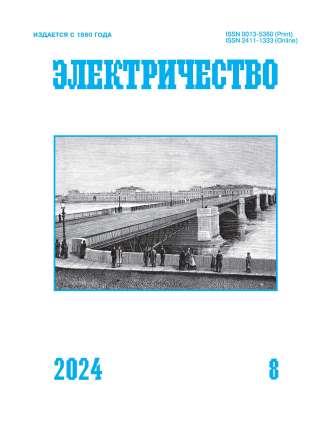Calculation of Transients in Linear Electrical Circuits Using the Pade Approximation of a Matrix Exponent
DOI:
https://doi.org/10.24160/0013-5380-2024-8-26-35Keywords:
electrical circuits, transients, stiff systems, oscillatory systems, high precision methods, L-stable methods, Pade approximation, matrix exponentAbstract
The article considers the application of a new family of implicit high-precision numerical methods to the calculation of transients in linear electrical circuits. The methods are applicable for calculating processes in conventional circuits, as well as in circuits with rigid and oscillatory systems of equations and in circuits with frequent switching. The basis of the methods is the Cauchy formula, in which the matrix exponent is represented as a Pade approximation. This approximation is decomposed into the simplest matrix fractions. As a result, simple formulas are obtained in which the matrices are formed directly from the circuit diagram, similar to the way it is done in the nodal potential method. As a result, to calculate the state of the circuit at the next step of integration, only the parameters of the circuit elements, the circuit incidence matrix, as well as the voltages and currents of energy sources specified within the integration step by their values or coefficients of local polynomials are needed. By using the new methods, it is possible to calculate processes in circuits with constant parameters and with piecewise constant parameters fixed within each integration step. The methods feature simplicity, versatility and low computational costs.
References
2. Бурцев Ю.А. Решение задачи Коши высокоточными методами на основе аппроксимации Паде матричной экспоненты ‒ Труды института системного анализа РАН, 2024, № 1, с. 3–11.
3. Чуа Л.О., Пен-Мин Лин. Машинный анализ электронных схем (алгоритмы и вычислительные методы). М.: Энергия, 1980, 640 с.
4. Курганов С.А., Филаретов В.В. Формирование уравнений состояния линейных электрических цепей с обобщенными индуктивными сечениями и емкостными контурами. ‒ Электричество, 2013, № 9, с. 49–55.
5. Скворцов Л.М. Численное решение обыкновенных дифференциальных и дифференциально-алгебраических уравнений. М.: ДМК Пресс, 2018, 230 c.
6. Современные численные методы решения обыкновенных дифференциальных уравнений / под ред. Дж. Холла и Дж. Уатта. М.: Мир, 1979, 312 с.
7. Гридин В.Н., Михайлов В.Б., Шустерман Л.Б. Численно-аналитическое моделирование радиоэлектронных схем. М.: Наука, 2008, 339 с.
8. Бурцев Ю.А. Сравнение программы расчета электрических цепей на основе модифицированного табличного метода с известными аналогами. ‒ Известия высших учебных заведений. Электромеханика, 2013, № 4, с. 8–13.
9. Сафаров Х.С. и др. О выборе численных методов интегрирования уравнений переходных процессов в электротехнических системах. ‒ Электричество, 2022, № 4, с. 40–46.
10. Хайрер Э., Нёрсетт С., Ваннер Г. Решение обыкновенных дифференциальных уравнений. Жесткие и дифференциально-алгебраические задачи. М.: Мир, 1999, 685 c.
11. Ракитский Ю.В., Устинов С.М., Черноруцкий И.Г. Численные методы решения жестких систем. М.: Наука, 1979, 208 с.
12. Crow M.L., Ilic M.D. The Waveform Relaxation Method for Systems of Differential/Algebraic Equations. – Mathematical and Computer Modelling, 1994, vol. 19(12), pp. 67–84.
13. Артым А.Д., Филин В.А., Есполов К.Ж. Новый метод расчета процессов в электрических цепях. СПб.: Элмор, 2001, 192 с.
14. Пилипенко А.М. Гибридные методы высокого порядка точности для численного анализа во временной области жестких и колебательных цепей. ‒ Моделирование, оптимизация и информационные технологии, 2017, № 3(18), с. 2–13.
15. Гантмахер Ф.Р. Теория матриц. М.: Физматлит, 2010, 560 с.
16. Бейкер Дж., Грейвс-Моррис П. Апрроксимации Паде. М.: Мир, 1986, 502 с.
17. Тыртышников Е.Е. Методы численного анализа. М.: МГУ, 2006, 276 с.
18. Тыртышников Е.Е. Курс линейной алгебры. М.: МГУ, 2005, 299 с.
#
1. Burtsev Yu. High Precision Methods Based on Pade Approximation of Matrix Exponent for Numerical Analysis of Stiff-Oscillatory Electrical Circuits. – International Conference on Industrial Engineering, Applications and Manufacturing, 2020, DOI:10.1109/ICIEAM48468.2020.9112007.
2. Burtsev Yu.А. Trudy instituta sistemnogo analiza RAN ‒ in Russ. (Proceedings of the Institute of System Analysis of the Russian Academy of Sciences), 2024, No. 1, pp. 3–11.
3. Chua L.O., Pen-Min Lin. Mashinnyy analiz elektronnyh skhem (algoritmy i vychislitel'nye metody) (Machine Analysis of Electronic Circuits (Algorithms and Computational Methods)). M.: Energiya, 1980, 640 p.
4. Kurganov S.A., Filaretov V.V. Elektrichestvo – in Russ. (Electricity), 2013, No. 9, pp. 49–55.
5. Skvortsov L.M. Chislennoe reshenie obyknovennyh differentsial'nyh i differentsial'no-algebraicheskih uravneniy (Numerical Solution of Ordinary Differential and Differential Algebraic Equations). М.: DМК Пресс, 2018, 230 p.
6. Sovremennye chislennye metody resheniya obyknovennyh differentsial'nyh uravneniy (Modern Numerical Methods for Solving Ordinary Differential Equations) / By Ed. J. Hall and J. Watt. М.: Mir, 1979, 312 p.
7. Gridin V.N., Mihaylov V.B., Shusterman L.B. Chislenno-analiticheskoe modelirovanie radioelektronnyh skhem (Numerical and Analytical Modeling of Electronic Circuits). М.: Nauka, 2008, 339 p.
8. Burtsev Yu.А. News of higher educational institutions. Electromechanics ‒ in Russ. (News of Higher Educational Institutions. Electromechanics), 2013, No. 4, pp. 8–13.
9. Safarov H.S. et al. Elektrichestvo – in Russ. (Electricity), 2022, No. 4, pp. 40–46.
10. Hayrer E., Nyorsett S., Vanner G. Reshenie obyknovennyh differentsial'nyh uravneniy. Zhestkie i differentsial'no-algebraicheskie zadachi (Solving Ordinary Differential Equations. Rigid and Differential Algebraic Problems). М.: Мir, 1999, 685 p.
11. Rakitskiy Yu.V., Ustinov S.M., Chernorutskiy I.G. Chislen-nye metody resheniya zhestkih sistem (Numerical Methods for Solving Rigid Systems). М.: Наука, 1979, 208 p.
12. Crow M.L., Ilic M.D. The Waveform Relaxation Method for Systems of Differential/Algebraic Equations. – Mathematical and Computer Modelling, 1994, vol. 19(12), pp. 67–84.
13. Artym A.D., Filin V.A., Espolov K.Zh. Novyy metod rascheta protsessov v elektricheskih tsepyah (A New Method for Calculating Processes in Electrical Circuits). SPb.: Elmor, 2001, 192 p.
14. Pilipenko А.М. Gibridnye metody vysokogo poryadka tochnosti dlya chislennogo analiza vo vremennoy oblasti zhestkix i kolebatel'nyx tsepey ‒ in Russ. (Modeling, optimization and information technology), 2017, No. 3(18), pp. 2–13.
15. Gantmaher F.R. Teoriya matrits (Matrix theory). М.: Fizmatlit, 2010, 560 p.
16. Beyker Dzh., Greyvs-Morris P. Approksimatsii Pade (Approximation of the Case). М.: Мir, 1986, 502 p.
17. Tyrtyshnikov Е.Е. Metody chislennogo analiza (Methods of Numerical Analysis). М.: МGU, 2006, 276 p.
18. Tyrtyshnikov Е.Е. Kurs lineynoy algebry (Linear Algebra Course). М.: МGU, 2005, 299 p




